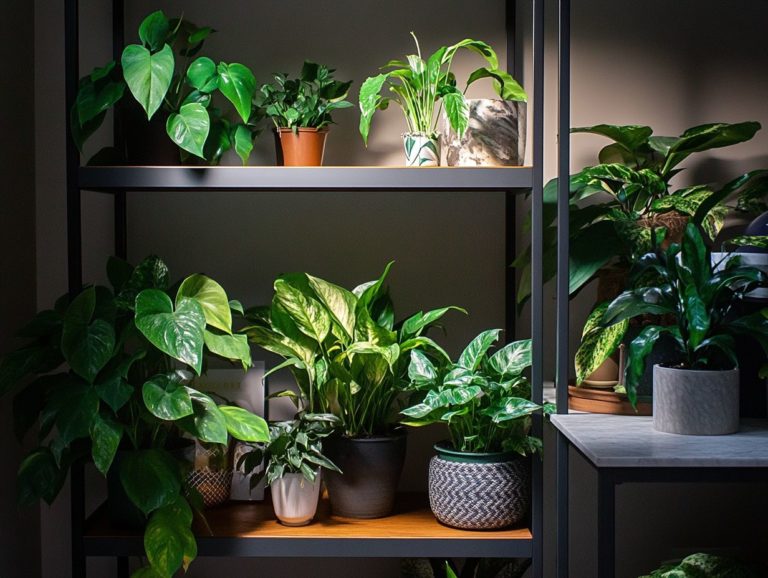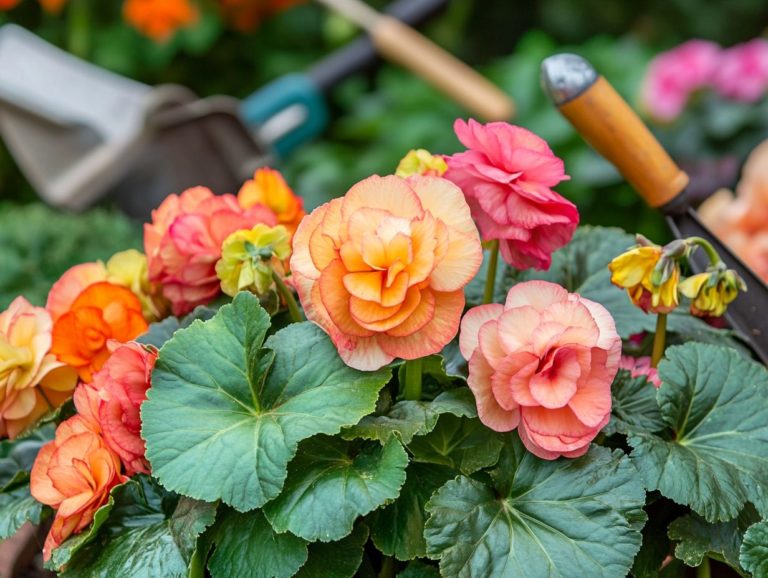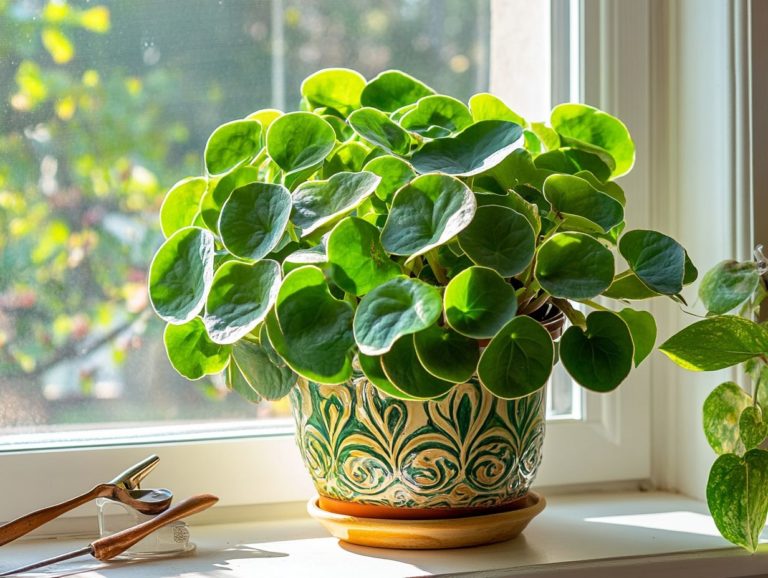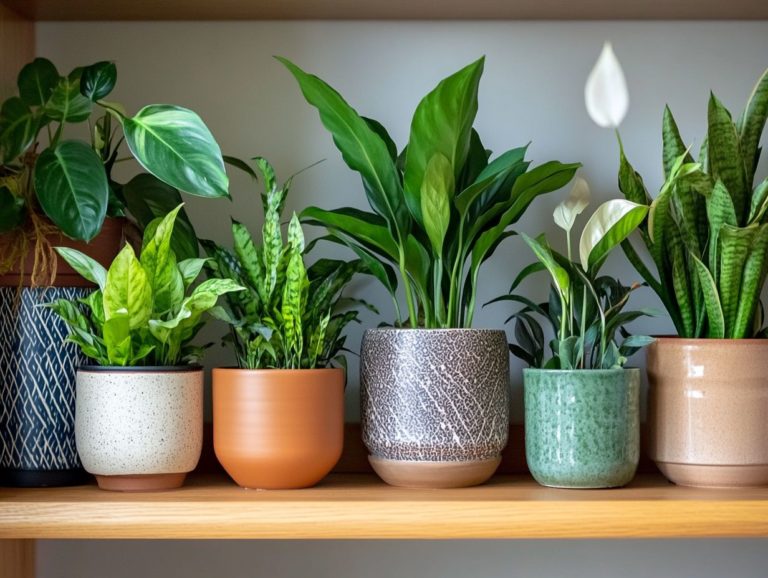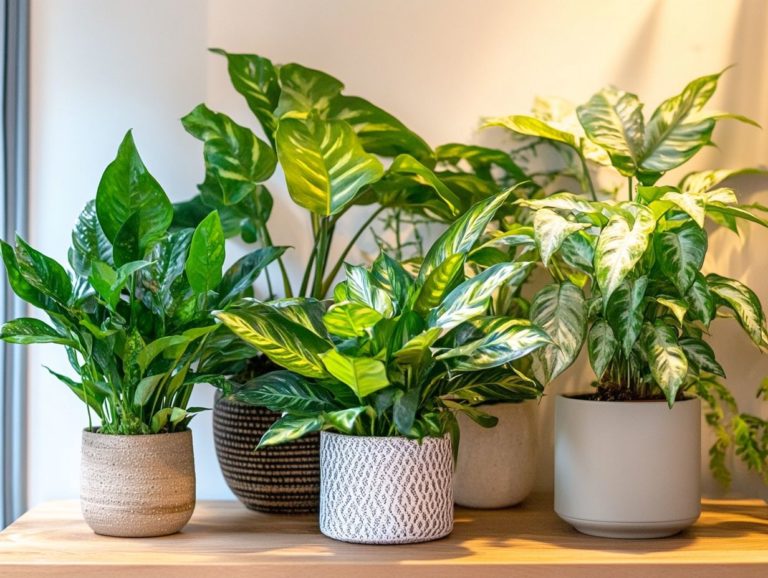Learning About Indoor Flowering Plants
Indoor flowering plants infuse your space with vibrant color and life. They elevate your home s atmosphere and enhance air quality.
Selecting the right plants is essential. You ll need to consider important factors like light conditions and temperature preferences.
Giving them the proper care especially in terms of watering and fertilizing will ensure these lively companions flourish.
This guide has you covered with insights on popular varieties and tips for tackling pest issues, equipping you with everything necessary to craft a breathtaking indoor floral display.
Dive in now and discover how to nurture your green thumb!
Contents
- Key Takeaways:
- Benefits of Having Indoor Flowering Plants
- Choosing the Right Indoor Flowering Plants
- Caring for Indoor Flowering Plants
- Common Indoor Flowering Plants
- Troubleshooting Common Issues
- Creating an Indoor Flowering Plant Display
- Frequently Asked Questions
- What are some benefits of having indoor flowering plants?
- What are some popular types of indoor flowering plants?
- Do indoor flowering plants require a lot of maintenance?
- Can I grow indoor flowering plants in low-light conditions?
- Are there any health considerations when it comes to indoor flowering plants?
- How can I incorporate indoor flowering plants into my home decor?
Key Takeaways:

- Enjoy the beauty and health benefits of indoor flowering plants, including improved air quality and stress reduction.
- Consider the lighting, temperature, and your commitment to caring for your chosen plants.
- Provide proper care by watering and fertilizing appropriately, along with the right amount of light and temperature.
Benefits of Having Indoor Flowering Plants
Incorporating indoor flowering plants like the peace lily, Kalanchoe, and Anthurium into your living space brings a wealth of benefits. They enhance air quality, elevate your mental well-being, and provide a creative boost.
These vibrant plants serve as natural air purifiers, reducing stress and enhancing productivity.
Regularly tending to these low-maintenance flowers cultivates a serene atmosphere that nurtures creativity and increases humidity levels. This transforms your home into a truly inviting sanctuary filled with colorful blooms.
Choosing the Right Indoor Flowering Plants
Selecting ideal indoor flowering plants requires considering light requirements, moisture needs, and the overall environmental conditions in your home. By understanding which plants, such as the elegant Phalaenopsis orchid or the vibrant lipstick plant, thrive in your specific indoor setting, you can cultivate a flourishing collection of stunning flowers.
This thoughtful approach enhances your space while also considering how the plants look, ensuring a harmonious balance in your home.
Factors to Consider
When selecting indoor flowering plants, several key factors deserve your attention, including light requirements, moisture needs, and soil type. For example, the African violet flourishes in indirect sunlight, while the desert rose revels in bright light. Aligning your plant selections with your home environment is essential for optimal growth.
Understanding moisture needs is critical for plant health. Both overwatering and underwatering can stress even the hardiest species. A well-draining soil mix is vital for plants like succulents, which thrive on minimal moisture. In contrast, moisture-loving varieties such as peace lilies do well in richer soils that retain humidity.
If you’re just starting out, consider choosing easy-care flowers like pothos or snake plants. These resilient plants adapt to a range of light and moisture conditions, simplifying your gardening journey.
Remember, each of these elements light, moisture, and soil plays a significant role in ensuring that your selected plants not only survive but truly thrive, transforming your space into a vibrant indoor oasis.
Caring for Indoor Flowering Plants
Caring for your indoor flowering plants requires a thoughtful approach to watering and fertilizing. Ensure they receive the perfect balance of moisture, nutrients, and attention to truly thrive.
By understanding the specific needs of plants like Gardenias and Zinnias, you can significantly enhance their growth and longevity. This also allows you to reap the therapeutic benefits they offer, contributing to overall enhanced mental health.
Start your indoor garden today and watch your space come to life!
Watering and Fertilizing

Proper watering and fertilizing are essential for indoor plant care. They help your flowering plants retain moisture and get the nutrients they need.
For example, the Christmas cactus needs less water than the Amaryllis. This shows the importance of tailored care for different plant species.
Understanding each plant’s water needs is crucial for their health. Watering from the bottom can help maintain moisture, especially for plants in well-draining soils.
Choosing the right fertilizer, organic or synthetic, ensures your plants get nutrients during the growing season. Monitoring soil moisture with a moisture tester or even your finger can make a big difference.
By focusing on these details, you can enjoy lush growth and vibrant blooms in your indoor garden!
Light and Temperature Requirements
Understanding your plants’ light and temperature needs is key to their growth. The Phalaenopsis orchid, for instance, thrives in indirect sunlight and stable temperatures.
In contrast, the African violet does well in lower light. This highlights the variety of needs among popular indoor plants.
Creating the right environment is essential. Too much light can scorch some plants, while others may not bloom if they don t get enough light.
Peace lilies prefer low to moderate light and should be kept out of direct sunlight. Most flowering plants enjoy temperatures between 65 F and 75 F.
Here’s a quick tip: keep your plants away from drafty windows and heaters. This will help prevent temperature fluctuations!
Also, monitor humidity, especially for humidity-loving plants like the bromeliad. They thrive in a moist environment.
Common Indoor Flowering Plants
Explore the world of common indoor flowering plants. They not only beautify your space but also improve air quality!
The peace lily and Kalanchoe are great examples. They are both stunning and low-maintenance, perfect for beginners and seasoned gardeners alike.
Popular Varieties and Care Tips
The Hibiscus and Bromeliad stand out with their vibrant blooms. Understanding their moisture and light needs will boost their growth.
Consider the Peace Lily with its elegant white flowers. It thrives in low to medium light with evenly moist soil.
The African Violet loves bright, indirect light. Feeding them with a balanced fertilizer every few weeks enhances their blooming.
Explore the Geranium too! It prefers bright light and should be watered only when the top inch of soil is dry. This plant brings vibrancy to your indoor spaces!
Troubleshooting Common Issues
Addressing common issues with indoor flowering plants is vital for their health. Watch for pests like aphids and diseases such as powdery mildew.
Identifying symptoms early enables timely interventions. This proactive approach will help rescue your plants from decline.
Dealing with Pests and Diseases

Dealing with pests and diseases in your indoor flowering plants demands vigilance and care before problems start to prevent infestations. Common pests like aphids and spider mites can threaten your blooms. But with the right preventive measures, you can keep your indoor flowers looking vibrant.
It s important to regularly inspect your plants, keeping an eye out for any unusual leaf discoloration or webbing that might signal an infestation. Understanding the specific lifecycle and behavior of these pests empowers you to detect issues early on. Neglecting proper watering and humidity levels can weaken your plants, making them more vulnerable to diseases like powdery mildew a white fungus that can appear on leaves or root rot.
To bolster your plants’ resilience, adopt routine care practices such as proper pruning and using natural bug sprays. You can also keep beneficial insects, like ladybugs, to enhance your natural pest control strategies, ultimately ensuring the longevity and health of your cherished indoor blooms. Additionally, be mindful of the light requirements for flowering indoor plants to help them thrive.
Creating an Indoor Flowering Plant Display
Crafting an enchanting indoor flowering plant display does more than just elevate your home’s aesthetic appeal; it nurtures your creativity and cultivates a sense of tranquility.
By thoughtfully arranging plants such as the flowering maple and Cape primrose, you can achieve a visual harmony that transforms your living space into a refreshing sanctuary.
Tips for Arranging and Styling
When arranging and styling your indoor flowering plants, consider their size, color, and light requirements to craft a balanced and visually appealing display. Use taller plants like the Amaryllis as focal points, while smaller varieties such as African violets can elegantly fill in gaps and introduce layers of interest.
Reflect on the overall theme you wish to convey; harmonious color palettes can enhance the ambiance of the room. Group plants with similar light needs together to simplify care and promote healthy growth. For instance, positioning lush green plants alongside vibrant blooms creates a striking contrast that catches the eye.
Don t overlook height variation; stagger your plants at different elevations using decorative plant stands or shelves. This technique draws the eye upward, adding depth and ensuring that each plant is showcased beautifully, maximizing their aesthetic potential and transforming your space into a lush indoor oasis.
Watch this quick guide on how to care for your indoor flowering plants!
Frequently Asked Questions
What are some benefits of having indoor flowering plants?
Indoor flowering plants can improve the air quality in your home, reduce stress and anxiety, add a pop of color to your living space, and boost your mood.
What are some popular types of indoor flowering plants?

Some popular types of indoor flowering plants include orchids, peace lilies, African violets, and begonias.
Do indoor flowering plants require a lot of maintenance?
It depends on the specific plant, but most indoor flowering plants require minimal maintenance and can thrive with just regular watering and some natural light.
Can I grow indoor flowering plants in low-light conditions?
Yes, there are several types of indoor flowering plants that can thrive in low-light conditions, such as pothos, snake plants, and Chinese evergreens.
Are there any health considerations when it comes to indoor flowering plants?
Some indoor flowering plants, like lilies, can be toxic to pets if ingested. It’s important to research which plants are safe for your home if you have pets or young children.
How can I incorporate indoor flowering plants into my home decor?
There are many creative ways to display indoor flowering plants, such as using hanging planters, placing them in a decorative pot, or creating a terrarium. You can also rotate different plants throughout the year to keep your home decor fresh and vibrant.
Start your indoor garden today for a vibrant home!

